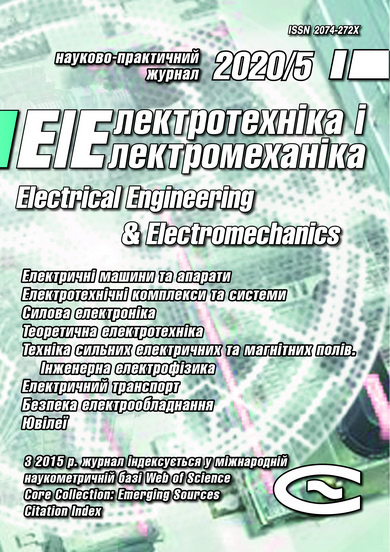CONTROL OF ELECTRIC SHIPS’ PROPULSION MOTORS WHEN MOVING ON CURVILINEAR TRAJECTORY
DOI:
https://doi.org/10.20998/2074-272X.2020.5.09Keywords:
electric ships’ propulsion motors, control on maneuvers, optimal control during curvilinear motion, optimization methodAbstract
Purpose. The aim of the work is to search for the optimal control of the electric ships’ propeller motors (PM) while moving on curvilinear trajectory. The indices characterizing the vessel were selected as the criteria of optimality. Methodology. Optimal control laws of PM providing electric ships’ best maneuverability can be found by joint consideration of the electric propelling plant (EPP), propellers and hull. Results. A method of calculating the transient regimes of the electric ships’ propulsion complexes during maneuver has been developed. A new method of forming the PM control laws is proposed. The nature of the target functions is revealed and a method of optimizing the parameters of control signals is developed. Optimization calculations have been carried out and the optimal control of the electric ships’ propeller motors when moving along curvilinear trajectory has been found. Optimization has been carried out by the criterion of minimum energy consumption and by the criterion of minimum ship’s distance. The optimization efficiency is illustrated. Scientific novelty. The method of searching for the optimal control laws is constructed according to the system principle, which allows optimizing the control of the propulsion motors by the final result. Practical value. The proposed recommendations can be used in the design of electric propelling plants and in their operation.References
Molland A. The maritime engineering reference book. A guide to ship design, construction and operation. Butterworth-Heinemann, Oxford, UK, 2008. 920 p. doi: doi:10.1016/b978-0-7506-8987-8.x0001-7.
Bertram V. Practical Ship Hydrodynamics. Butterworth-Heinemann, Oxford, UK, 2012. 390 p. doi: 10.1016/C2010-0-68326-X.
Carlton J.S. Marine propellers and propulsion. 4th edition. Butterworth-Heinemann, Oxford, UK, 2018. 609 p. doi: 10.1016/C2014-0-01177-X.
Nebesnov V.I. Dinamika dvigatelia v sisteme korpus sudna-vinty-dvigateli [Engine dynamics in the ship hull-propeller-engine system].Leningrad, Sudpromgiz Publ., 1961. 374 p. (Rus).
Leonhard W. Control of electrical drives. Springer-Verlag Berlin Heidelberg, 2001. 241 p. doi: 10.1007/978-3-642-56649-3.
Bose B.K. Power electronics and AC drives. Prentice Hall,Englewood Cliffs,New York, 2001. 738 p.
Mohan N., Undeland T.M., Robbins W.P. Power electronics, converters, applications and design. J. Wiley,New York, 2003. 811 p.
Yarovenko V.A., Chernikov P.S., Varbanets R.A., Zaritskaya E.I. Optimal control of the electric ships’ propulsion motors during reversal. Electrical engineering & electromechanics, 2018, no. 6, pp. 38-46. doi: 10.20998/2074-272X.2018.6.05.
Chernikov P.S., Yarovenko V.A., Zaritskaya E.I. The influence of control laws of frequency-regulated electric motors on electric ships’ maneuvering characteristics. Bulletin of NTU «KhPI». Series: «Electric machines and electromechanical energy conversion», 2020, no. 3 (1357), pp. 45-51. (Ukr). doi: 10.20998/2409-9295.2020.3.08.
Yarovenko V.A., Chernikov P.S. A calculation method of transient modes of electric ships’ propelling electric plants. Electrical engineering & electromechanics, 2017, no. 6, pp. 32-41. doi: 10.20998/2074-272X.2017.6.05.
Downloads
Published
How to Cite
Issue
Section
License
Copyright (c) 2020 V. A. Yarovenko, P. S. Chernikov, E. I. Zaritskaya, A. N. Schumylo

This work is licensed under a Creative Commons Attribution-NonCommercial 4.0 International License.
Authors who publish with this journal agree to the following terms:
1. Authors retain copyright and grant the journal right of first publication with the work simultaneously licensed under a Creative Commons Attribution License that allows others to share the work with an acknowledgement of the work's authorship and initial publication in this journal.
2. Authors are able to enter into separate, additional contractual arrangements for the non-exclusive distribution of the journal's published version of the work (e.g., post it to an institutional repository or publish it in a book), with an acknowledgement of its initial publication in this journal.
3. Authors are permitted and encouraged to post their work online (e.g., in institutional repositories or on their website) prior to and during the submission process, as it can lead to productive exchanges, as well as earlier and greater citation of published work.





